Optimal Relay Selection Scheme with Multiantenna Power Beacon for Wireless-Powered Cooperation Communication Networks
Abstract
1. Introduction
1.1. Background
1.2. Related Works
1.2.1. Single-Relay WPCCN
1.2.2. Multirelays WPCCN
- A multiantennas PB-WPCCN system model is proposed, where both the source and the relays set are assumed not connected to a fix power grid. Alternatively, they need to harvest energy first from the dedicated multiantennas PB and then work cooperatively to forward the information to the destination.
- A two-stage relay selection scheme is introduced, referred to as two-round relay selection (2-RRS) and compared with two popular relay selection schemes, i.e., partial relay selection (PRS) and opportunistic relay selection (ORS). The derived results show the proposed 2-RRS scheme’s performance compared to the conventional relay selection schemes in terms of system throughput, outage probability, and energy harvesting.
- The closed-form expressions of outage probability and average system throughput for the previous relay selections schemes and the proposed 2-RRS scheme are derived and validated by numerical simulation.
- The impact of multiantenna PB and other system parameters such as harvesting time, relays number, and position on the system performance are also investigated.
1.3. Organization of The Paper
2. System Model
2.1. System Description
- A1
- A2
- The power beacon is considered as a dedicated power source for the network as proposed in [22,23]. PB, S, Ri, D nodes are considered completely coordinated and run according to harvest and cooperate protocol. Uplink channel estimations without pilot contamination are assumed to be ideal, which employed for downlink ZF precoding computation based on channel reciprocity.
- A3
- As highlighted in [11,31], we assume that both the source and the relay candidates expend their amount of energy harvested in the transmission phases. Note that it is possible to consider power allocation methods here to enhance the efficiency of the system further. The above assumption is regarded as a lower bound of our proposed system model.
2.2. Signal Modeling
2.2.1. Energy Beamforming Phase
2.2.2. Information Transmission Phase
3. Relay Selection Schemes
3.1. Opportunistic Relay Selection (ORS) Scheme
3.2. Partial Relay Selection (PRS) Scheme
3.3. The Proposed Two-Round Relay Selection (2-RRS) Scheme
- By using the energy harvested in the first phase S deliver information to in the second phase. After receive S information each relay candidate sends his state information (the received SNR over link and the amount of the EH from multiantennas PB) to D. The received SNR in each relay is compared with a predefined SNR threshold value . The M relays where which their SNR satisfy are correctly decode S information and they will qualify for the second-round selection. We denote the selected group of relays as and the best-selected relay as .
- In the second selection round, the destination will choose the best of relay group candidate aswhere is the SNR of the relay candidate in the to D via the link , which can be written asThe destination broadcasts the final choosing result to all relay candidates. Then, the selected optimal relay forwards the recoded information to the destination. The whole 2-RRS relay selection scheme is summarized with the following Algorithm 1:
| Algorithm 1: Two-Round Relay Selection (2-RRS) Scheme Algorithm. |
| Input: Define N number of relay, ; |
| while S transmit to N Relays |
| Update ; |
| First Round Selection |
| for |
| Initialize ; |
| while |
| update the group ; |
| There are M relay successfully decode S information, ; |
| end while |
| end for |
| Second Round Selection: |
| if then |
| Find the best relay maximizing ; |
| end if |
| end while |
4. Performance Analysis
4.1. Outage Performance of the Proposed 2-RRS Scheme
4.2. Outage Performance of the ORS Scheme
4.3. Outage Performance of the PRS Scheme
4.4. System Throughput
5. Numerical Results and Discussion
6. Conclusions
Author Contributions
Funding
Institutional Review Board Statement
Informed Consent Statement
Conflicts of Interest
References
- Paradiso, J.A.; Starner, T. Energy scavenging for mobile and wireless electronics. IEEE Pervasive Comput. 2005, 4, 18–27. [Google Scholar] [CrossRef]
- Varshney, L.R. Transporting information and energy simultaneously. In Proceedings of the 2008 IEEE International Symposium on Information Theory, Toronto, ON, Canada, 6–11 July 2008; pp. 1612–1616. [Google Scholar]
- Ju, H.; Zhang, R. Optimal resource allocation in full-duplex wireless-powered communication network. IEEE Trans. Commun. 2014, 62, 3528–3540. [Google Scholar] [CrossRef]
- Zuo, Y. Survivable RFID systems: Issues, challenges, and techniques. IEEE Trans. Syst. Man Cybern. Part C Appl. Rev. 2010, 40, 406–418. [Google Scholar]
- Choi, C.W. Basic MAC Scheme for RF Energy Harvesting Wireless Sensor Networks: Throughput Analysis and Optimization. Sensors 2019, 19, 1822. [Google Scholar] [CrossRef]
- Yoo, T.; Goldsmith, A. On the optimality of multiantenna broadcast scheduling using zero-forcing beamforming. IEEE J. Sel. Areas Commun. 2006, 24, 528–541. [Google Scholar]
- Pi, Z.; Khan, F. An introduction to millimeter-wave mobile broadband systems. IEEE Commun. Mag. 2011, 49, 101–107. [Google Scholar] [CrossRef]
- Khodamoradi, V.; Sali, A.; Messadi, O.; Salah, A.A.; Al-Wani, M.M.; Ali, B.M.; Abdullah, R.S.A.R. Optimal Energy Efficiency Based Power Adaptation for Downlink Multi-Cell Massive MIMO Systems. IEEE Access 2020, 8, 203237–203251. [Google Scholar] [CrossRef]
- Kim, S.H.; Kim, J.W.; Kim, D.S. Energy Consumption Analysis of Beamforming and Cooperative Schemes for Aircraft Wireless Sensor Networks. Appl. Sci. 2020, 10, 4374. [Google Scholar] [CrossRef]
- Yuan, T.; Liu, M.; Feng, Y. Performance Analysis for SWIPT Cooperative DF Communication Systems with Hybrid Receiver and Non-Linear Energy Harvesting Model. Sensors 2020, 20, 2472. [Google Scholar] [CrossRef]
- Chen, H.; Li, Y.; Rebelatto, J.L.; Uchoa-Filho, B.F.; Vucetic, B. Harvest-then-cooperate: Wireless-powered cooperative communications. IEEE Trans. Signal Process. 2015, 63, 1700–1711. [Google Scholar] [CrossRef]
- Nguyen, T.N.; Tran, M.; Ha, D.H.; Trang, T.T.; Vozňák, M. Multi-source in DF Cooperative Networks with the PSR Protocol Based Full-Duplex Energy Harvesting over a Rayleigh Fading Channel: Performance Analysis. Proc. Est. Acad. Sci. 2019, 68, 264–275. [Google Scholar] [CrossRef]
- Giuliano, R.; Cardarilli, G.C.; Cesarini, C.; Di Nunzio, L.; Fallucchi, F.; Fazzolari, R.; Mazzenga, F.; Re, M.; Vizzarri, A. Indoor Localization System Based on Bluetooth Low Energy for Museum Applications. Electronics 2020, 9, 1055. [Google Scholar] [CrossRef]
- Kareem, H.; Hashim, S.; Suberamaniam, S.; Sali, A. Energy Efficient Two Stage Chain Routing Protocol (TSCP) for wireless sensor networks. J. Theor. Appl. Inf. Technol. 2014, 59, 442–450. [Google Scholar]
- Zuo, Z.; Liu, L.; Zhang, L.; Fang, Y. Indoor positioning based on Bluetooth low-energy beacons adopting graph optimization. Sensors 2018, 18, 3736. [Google Scholar] [CrossRef] [PubMed]
- Amjad, M.; Ahmed, A.; Naeem, M.; Awais, M.; Ejaz, W.; Anpalagan, A. Resource Management in Energy Harvesting Cooperative IoT Network under QoS Constraints. Sensors 2018, 18, 3560. [Google Scholar] [CrossRef] [PubMed]
- Ju, H.; Zhang, R. Throughput maximization in wireless powered communication networks. IEEE Trans. Wirel. Commun. 2014, 13, 418–428. [Google Scholar] [CrossRef]
- Krikidis, I.; Timotheou, S.; Sasaki, S. RF energy transfer for cooperative networks: Data relaying or energy harvesting? IEEE Commun. Lett. 2012, 16, 1772–1775. [Google Scholar] [CrossRef]
- Nasir, A.A.; Zhou, X.; Durrani, S.; Kennedy, R.A. Relaying protocols for wireless energy harvesting and information processing. IEEE Trans. Wirel. Commun. 2013, 12, 3622–3636. [Google Scholar] [CrossRef]
- Nguyen, T.N.; Tran, M.; Nguyen, T.L.; Ha, D.H.; Voznak, M. Performance analysis of a user selection protocol in cooperative networks with power splitting protocol-based energy harvesting over Nakagami-m/Rayleigh channels. Electronics 2019, 8, 448. [Google Scholar] [CrossRef]
- Huang, K.; Lau, V.K. Enabling wireless power transfer in cellular networks: Architecture, modeling and deployment. IEEE Trans. Wirel. Commun. 2014, 13, 902–912. [Google Scholar] [CrossRef]
- Tin, P.T.; Dinh, B.H.; Nguyen, T.N.; Ha, D.H.; Trang, T.T. Power Beacon-Assisted Energy Harvesting Wireless Physical Layer Cooperative Relaying Networks: Performance Analysis. Symmetry 2020, 12, 106. [Google Scholar] [CrossRef]
- Hoang, T.M.; Tan, N.T.; Tran, X.N. Performance analysis of power beacon-assisted energy harvesting NOMA multi-user relaying system over Nakagami-m fading channels. AEU Int. J. Electron. Commun. 2020, 115, 153022. [Google Scholar] [CrossRef]
- Krikidis, I.; Thompson, J.; McLaughlin, S.; Goertz, N. Amplify-and-forward with partial relay selection. IEEE Commun. Lett. 2008, 12, 235–237. [Google Scholar] [CrossRef]
- Do, N.T.; Bao, V.N.Q.; An, B. Outage performance analysis of relay selection schemes in wireless energy harvesting cooperative networks over non-identical rayleigh fading channels. Sensors 2016, 16, 295. [Google Scholar] [CrossRef]
- Hieu, T.D.; Duy, T.T.; Choi, S.G. Performance evaluation of relay selection schemes in beacon-assisted dual-hop cognitive radio wireless sensor networks under impact of hardware noises. Sensors 2018, 18, 1843. [Google Scholar] [CrossRef]
- Li, X.; Liu, M.; Deng, D.; Li, J.; Deng, C.; Yu, Q. Power beacon assisted wireless power cooperative relaying using NOMA with hardware impairments and imperfect CSI. AEU Int. J. Electron. Commun. 2019, 108, 275–286. [Google Scholar] [CrossRef]
- Ye, J.; Liu, Z.; Zhao, H.; Pan, G.; Ni, Q.; Alouini, M.S. Relay selections for cooperative underlay CR systems with energy harvesting. IEEE Trans. Cogn. Commun. Netw. 2019, 5, 358–369. [Google Scholar] [CrossRef]
- Messadi, O.; Sali, A.; Pan, G.; Ding, Z.; Noordin, N.K.; Hashim, S.J. Outage Performance for Power Beacon-Assisted Wireless-Powered Cooperative Communications. In Proceedings of the 2019 IEEE 89th Vehicular Technology Conference (VTC2019-Spring), Kuala Lumpur, Malaysia, 28 April–1 May 2019; pp. 1–6. [Google Scholar]
- Ma, Y.; Chen, H.; Lin, Z.; Li, Y.; Vucetic, B. Distributed and optimal resource allocation for power beacon-assisted wireless-powered communications. IEEE Trans. Commun. 2015, 63, 3569–3583. [Google Scholar] [CrossRef]
- Bletsas, A.; Shin, H.; Win, M.Z. Cooperative communications with outage-optimal opportunistic relaying. IEEE Trans. Wirel. Commun. 2007, 6, 3450–3460. [Google Scholar] [CrossRef]
- Hoydis, J.; Kobayashi, M.; Debbah, M. Green small-cell networks. IEEE Veh. Technol. Mag. 2011, 6, 37–43. [Google Scholar] [CrossRef]
- Krikidis, I. Relay selection in wireless powered cooperative networks with energy storage. IEEE J. Sel. Areas Commun. 2015, 33, 2596–2610. [Google Scholar] [CrossRef]
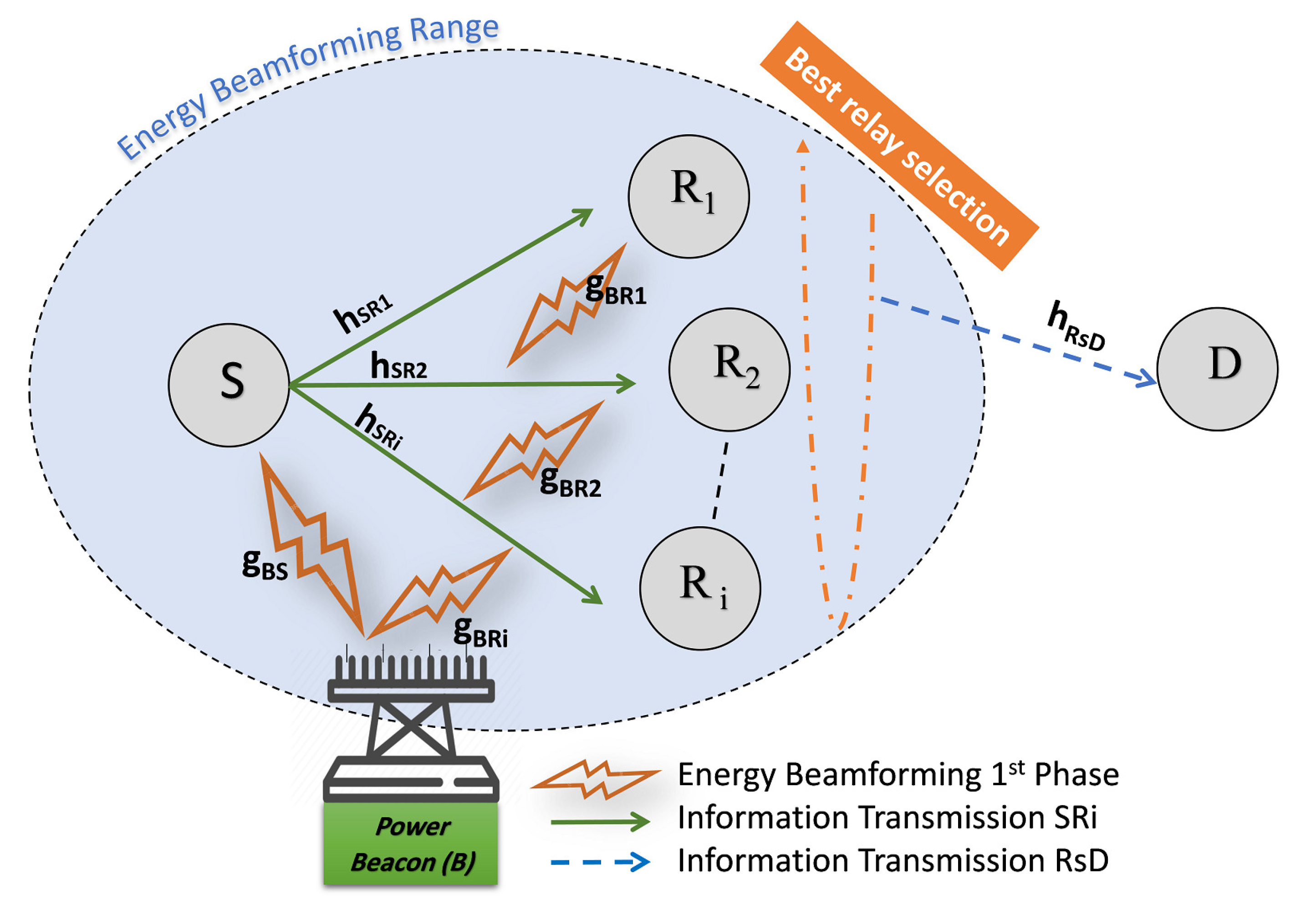

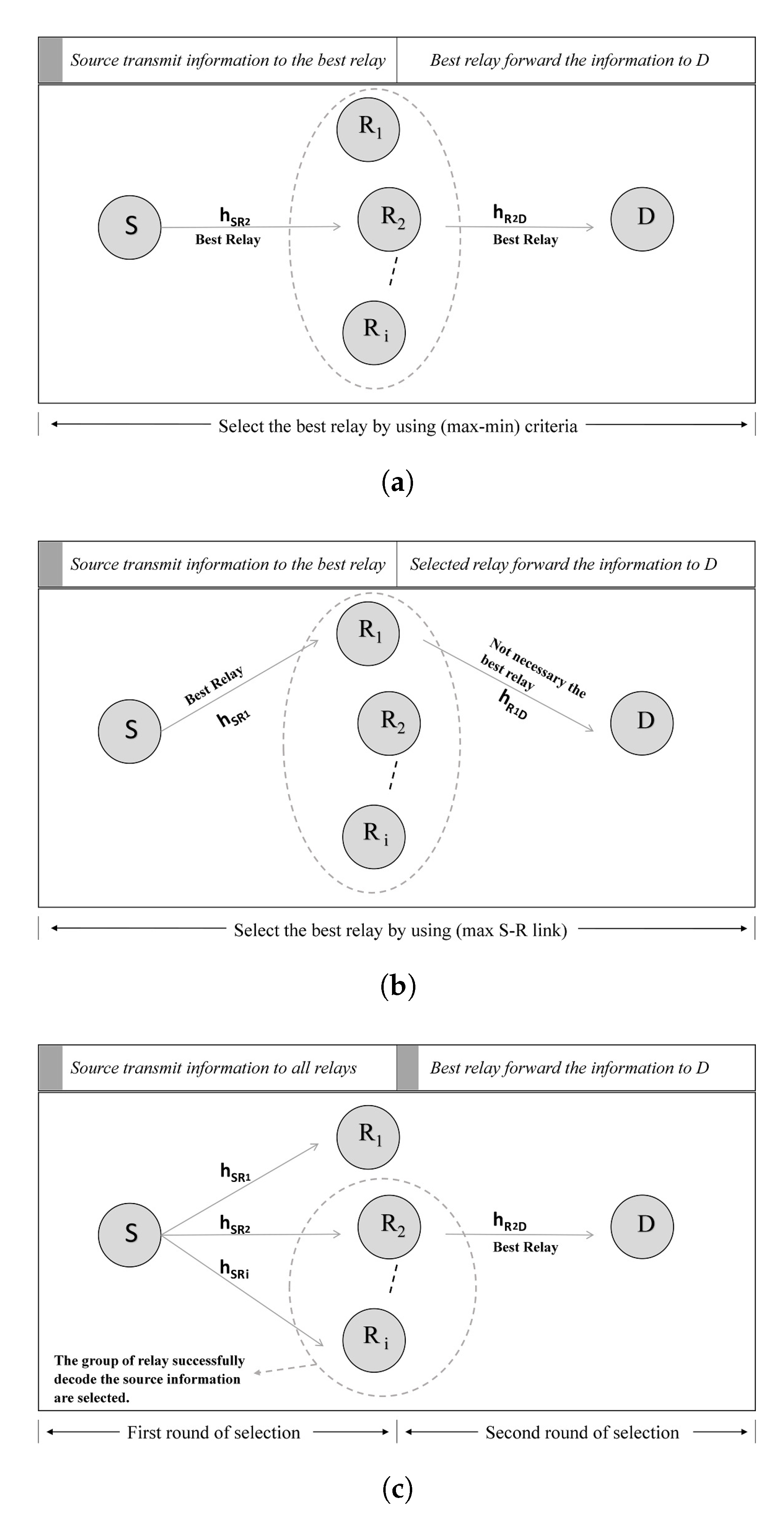


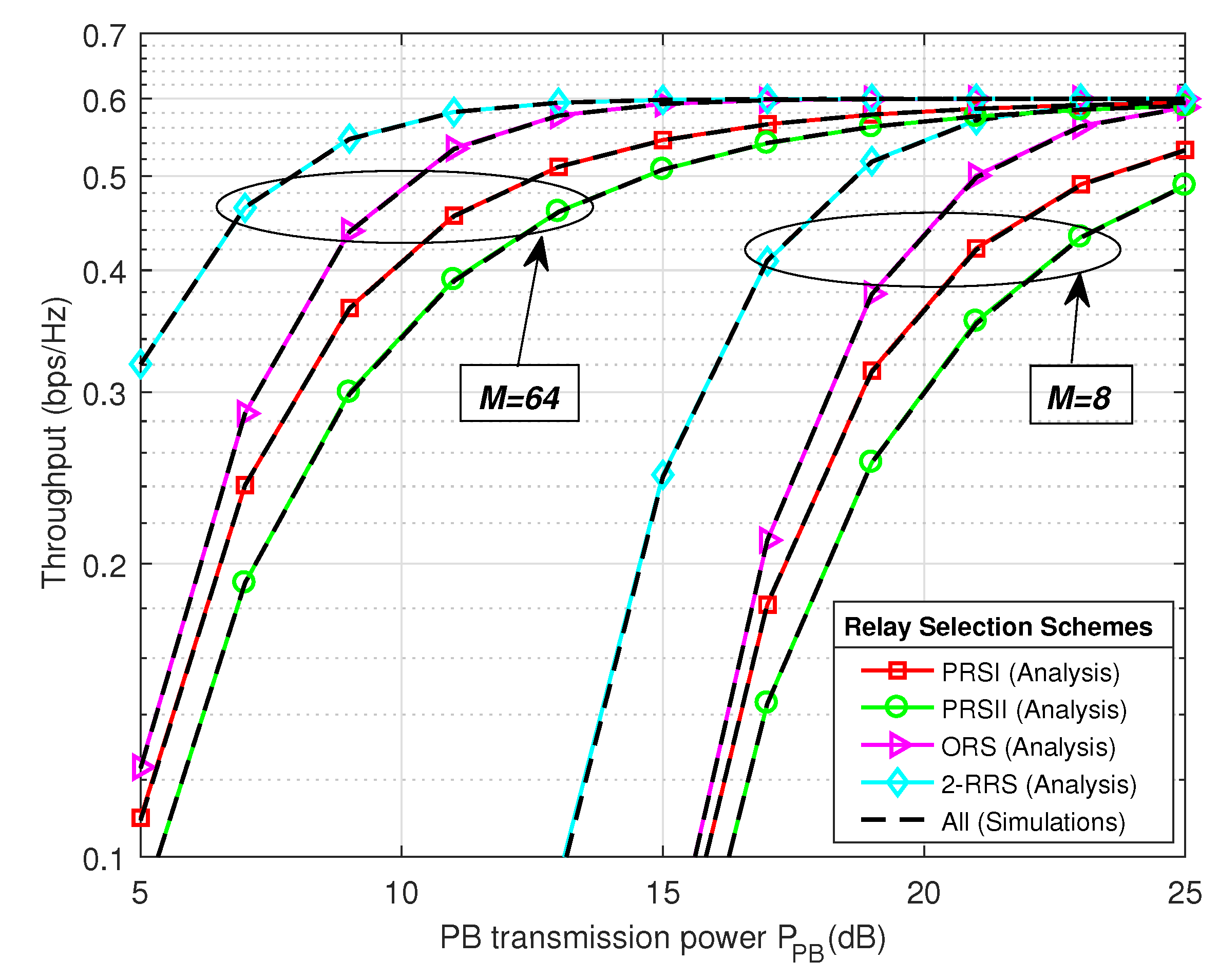
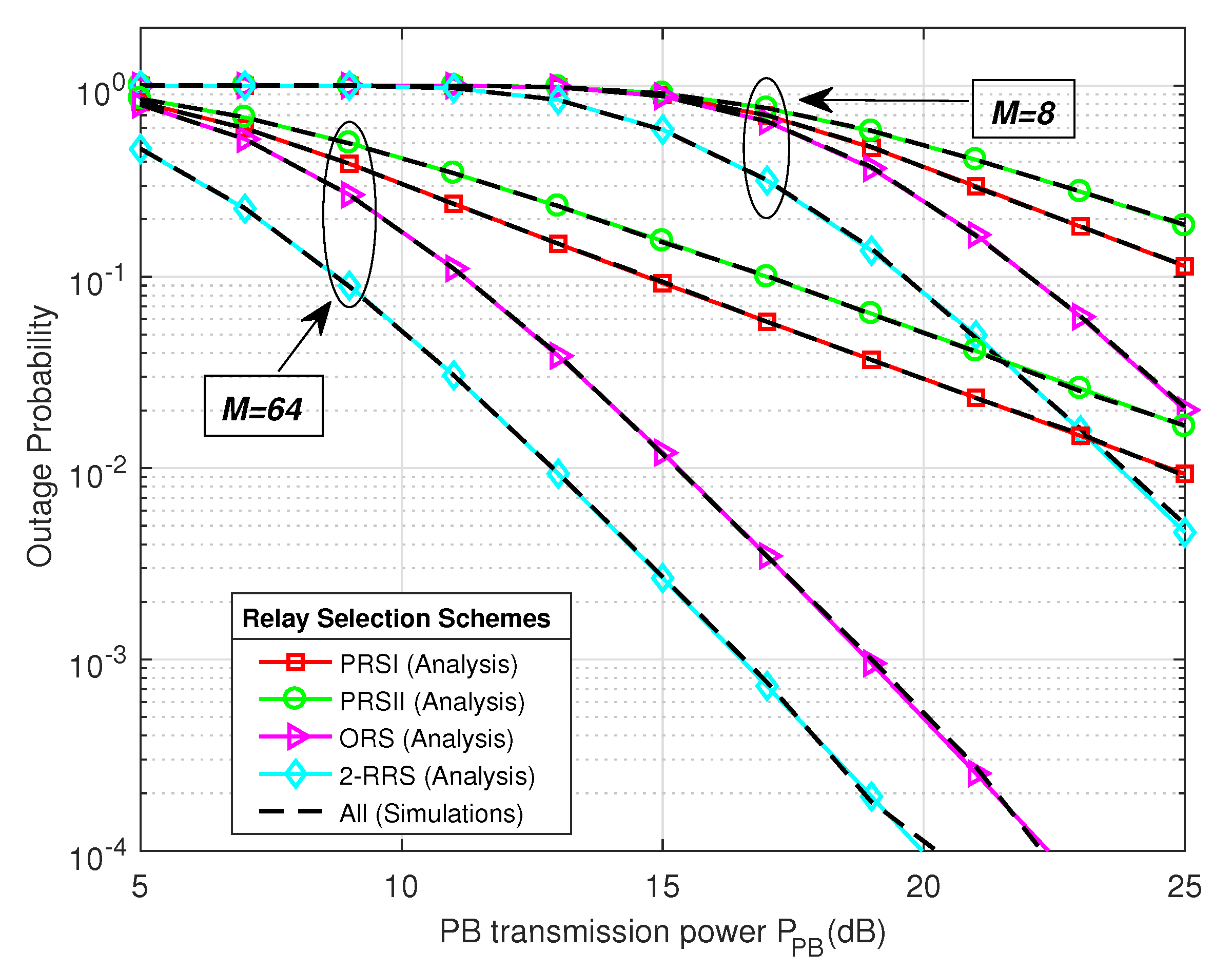
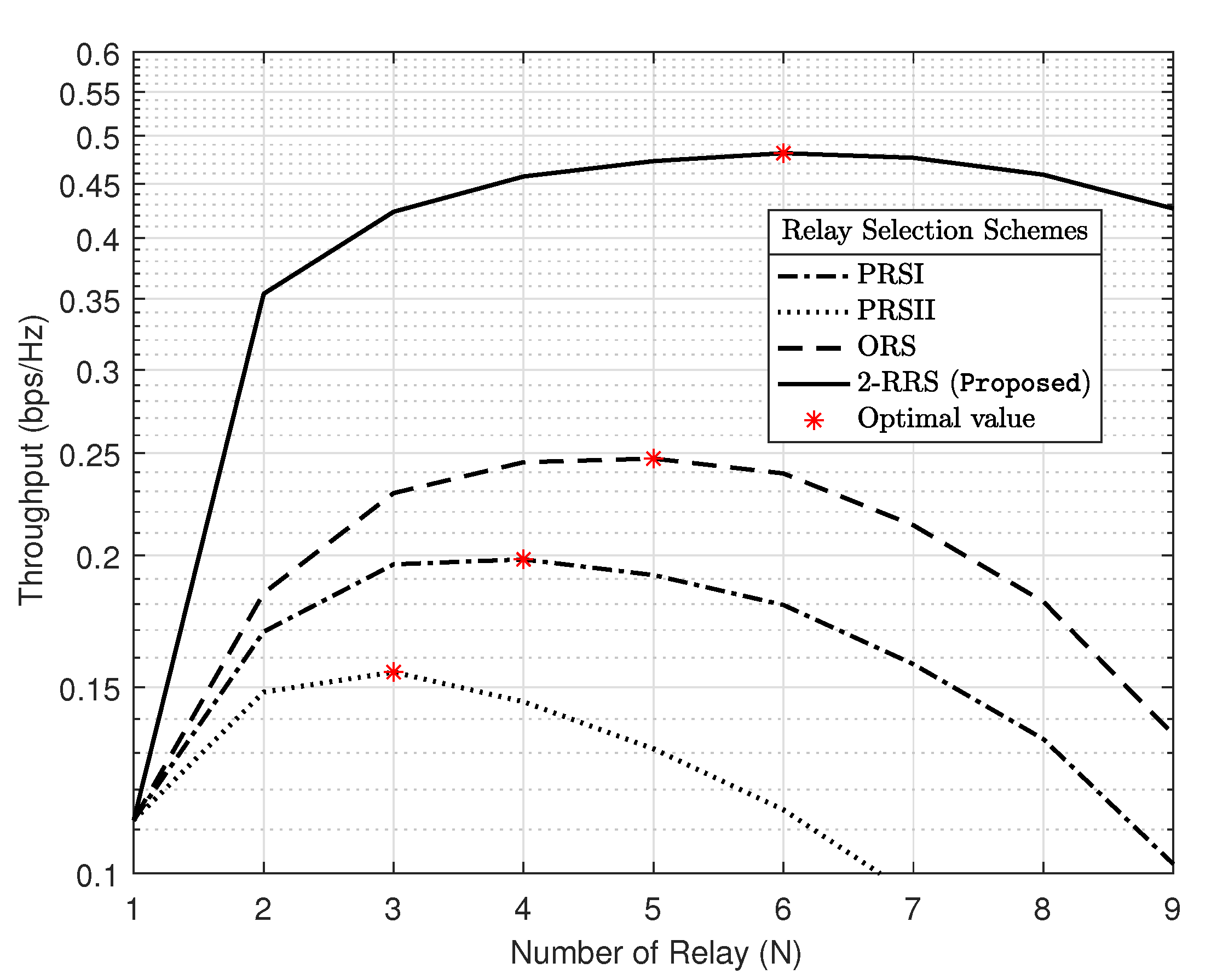
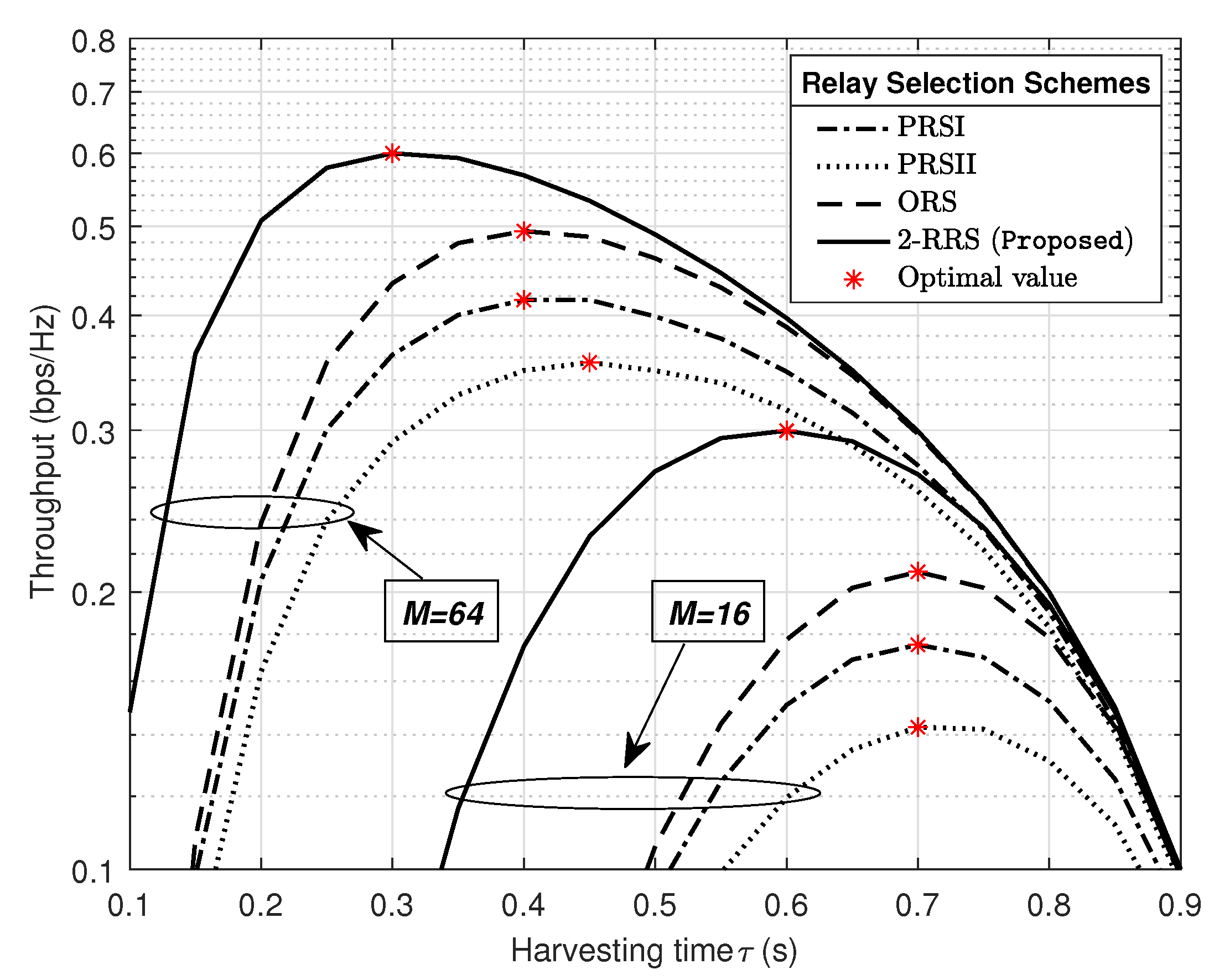

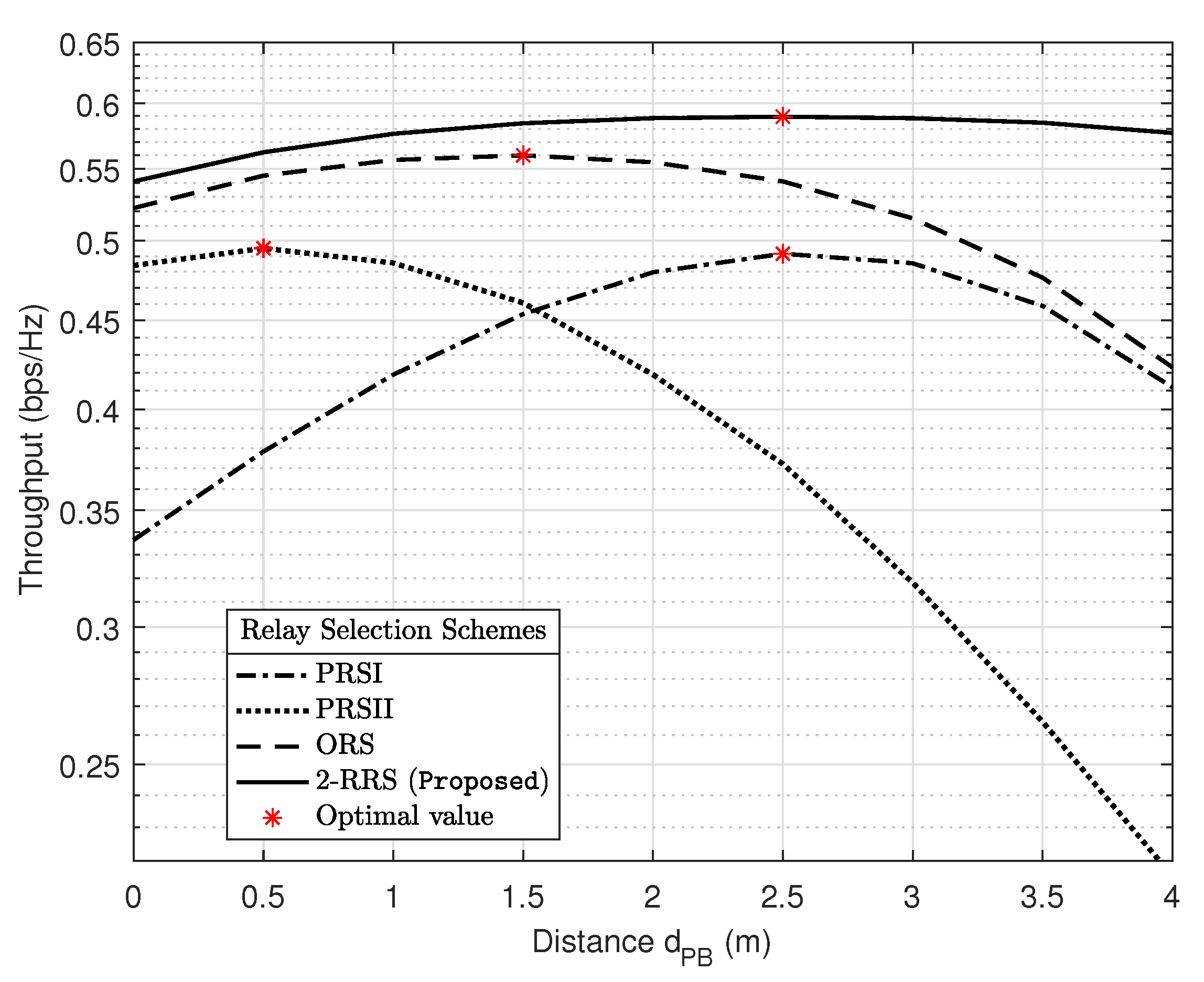
| System Parameter | Value |
|---|---|
| The number of relays | |
| The number of antennas of PB | |
| The transmission rate of the source | bps/Hz |
| Energy conversion efficiency | |
| Time block | s |
| Harvesting time | s |
| Distance from S-Ri | m |
| Distance from S-D | m |
| Distance from PB-S and PB-Ri | m |
| Noise power | [33] |
| The fading severity |
| Throughput (bps/Hz) | Outage Probability | |||||
|---|---|---|---|---|---|---|
| 2-RRS (Proposed) Over ORS [11,25,26] | 2-RRS (Proposed) Over PRSI [11,25,26] | 2-RRS (Proposed) Over PRSII [11,25,26] | 2-RRS (Proposed) Over ORS [11,25,26] | 2-RRS (Proposed) Over PRSI [11,25,26] | 2-RRS (Proposed) Over PRSII [11,25,26] | |
| dB | +0.0742 (15.02%) | +0.1533 (36.95%) | +0.2182 (62.34%) | −0.1224 (69.57%) | −0.2543 (82.61%) | −0.3653 (87.22%) |
| dB | +0.0055 (0.93%) | +0.0536 (9.84%) | +0.0909 (17.91%) | −0.0095 (78.20%) | −0.0896 (97.12%) | −0.1510 (98.27%) |
| dB | +0.0002 (0.03%) | +0.0176 (3.02%) | +0.0306 (5.38%) | −0.0004 (77.66%) | −0.0287 (99.64%) | −0.0520 (99.80%) |
Publisher’s Note: MDPI stays neutral with regard to jurisdictional claims in published maps and institutional affiliations. |
© 2020 by the authors. Licensee MDPI, Basel, Switzerland. This article is an open access article distributed under the terms and conditions of the Creative Commons Attribution (CC BY) license (http://creativecommons.org/licenses/by/4.0/).
Share and Cite
Messadi, O.; Sali, A.; Khodamoradi, V.; Salah, A.A.; Pan, G.; Hashim, S.J.; Noordin, N.K. Optimal Relay Selection Scheme with Multiantenna Power Beacon for Wireless-Powered Cooperation Communication Networks. Sensors 2021, 21, 147. https://doi.org/10.3390/s21010147
Messadi O, Sali A, Khodamoradi V, Salah AA, Pan G, Hashim SJ, Noordin NK. Optimal Relay Selection Scheme with Multiantenna Power Beacon for Wireless-Powered Cooperation Communication Networks. Sensors. 2021; 21(1):147. https://doi.org/10.3390/s21010147
Chicago/Turabian StyleMessadi, Oussama, Aduwati Sali, Vahid Khodamoradi, Asem A. Salah, Gaofeng Pan, Shaiful J. Hashim, and Nor K. Noordin. 2021. "Optimal Relay Selection Scheme with Multiantenna Power Beacon for Wireless-Powered Cooperation Communication Networks" Sensors 21, no. 1: 147. https://doi.org/10.3390/s21010147
APA StyleMessadi, O., Sali, A., Khodamoradi, V., Salah, A. A., Pan, G., Hashim, S. J., & Noordin, N. K. (2021). Optimal Relay Selection Scheme with Multiantenna Power Beacon for Wireless-Powered Cooperation Communication Networks. Sensors, 21(1), 147. https://doi.org/10.3390/s21010147





